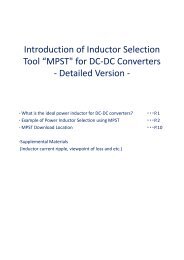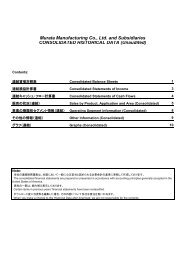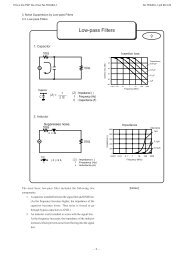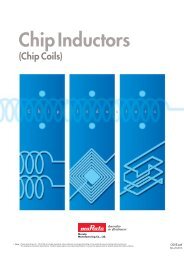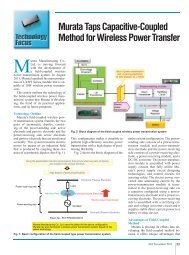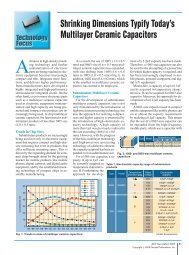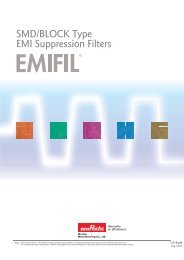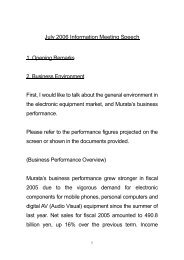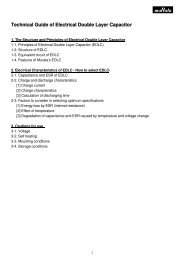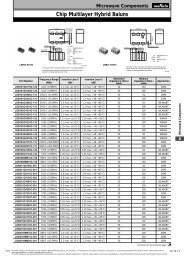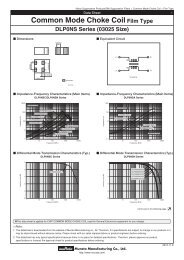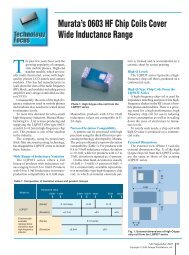Safety Standard Certified Ceramic Capacitors/High Voltage ... - Murata
Safety Standard Certified Ceramic Capacitors/High Voltage ... - Murata
Safety Standard Certified Ceramic Capacitors/High Voltage ... - Murata
Create successful ePaper yourself
Turn your PDF publications into a flip-book with our unique Google optimized e-Paper software.
!Note • Please read rating and !CAUTION (for storage, operating, rating, soldering, mounting and handling) in this catalog to prevent smoking and/or burning, etc.• This catalog has only typical specifications. Therefore, please approve our product specifi cations or transact the approval sheet for product specifi cations before ordering.C85E.pdfApr.7,2014Type KJ Specifications and Test MethodsOperating Temperature Range: -40 to +125°CNo.Item1 Appearance and Dimensions2 Marking To be easily legible3 Capacitance Within specified tolerance4 Dissipation Factor (D.F.)Char.B, E5 Insulation Resistance (I.R.) 10000MΩ min.SpecificationsNo visible defect, and dimensions are withinspecified range.SpecificationsD.F.V2.5%Test MethodThe capacitor should be visually inspected for evidence ofdefect.Dimensions should be measured with slide calipers.The capacitor should be visually inspected.The dissipation factor should be measured at 20°C with1±0.1kHz and AC5V(r.m.s.) max.The insulation resistance should be measured withDC500±50V within 60±5 sec. of charging.The voltage should be applied to the capacitor through aresistor of 1MΩ.Between LeadWiresNo failureThe capacitor should not be damaged when the test voltagesfrom Table 1 are applied between the lead wires for 60 sec.TypeKJTest <strong>Voltage</strong>AC2600V(r.m.s.)6DielectricStrengthBodyInsulationNo failureFirst, the terminals of the capacitorshould be connected together. Then,as shown in the figure at right, a metalfoil should be closely wrapped aroundthe body of the capacitor to thedistance of about 3 to 4mm fromeach terminal.Then, the capacitor should be insertedinto a container filled with metal ballsof about 1mm diameter. Finally, ACTypeKJTest <strong>Voltage</strong>AC2600V(r.m.s.)MetalFoilvoltage from Table 2 is applied for 60 sec. between thecapacitor lead wires and metal balls.about3 to 4mmMetalBalls7 Temperature Characteristics8 Solderability9Resistance toSolderingHeatAppearanceCapacitanceChangeI.R.DielectricStrengthChar. Capacitance ChangeBWithin ±10%EWithin +20–55%(Temp. range: -25 to +85°C)Lead wire should be soldered with uniform coatingon the axial direction over 3/4 of the circumferentialdirection.No marked defectWithin ±10%1000MΩ min.Per Item 6Step12345* "Room condition" Temperature: 15 to 35°C, Relative humidity: 45 to 75%, Atmospheric pressure: 86 to 106kPaThe capacitance measurement should be made at each stepspecified in Table 3.Temperature (ºC)20±2-25±220±285±220±2Pre-treatment:Capacitor should be stored at 125±3°C for 1 hr., then placedat room condition* for 24±2 hrs. before initial measurements.Should be placed into steam aging for 8 hrs.±15 min. After thesteam aging, the lead wire of a capacitor should be dipped intoan ethanol solution of 25% rosin and then into molten solder for5+0/-0.5 sec.The depth of immersion is up to about 1.5 to 2.0mm from theroot of lead wires.Temp. of solder: Lead Free Solder (Sn-3Ag-0.5Cu) 245±5°CH63 Eutectic Solder 235±5°CAs shown in the figure, the leadwires should be immersed in ThermalScreensolder of 260±5°C up to 1.5 to2.0mm from the root of terminal for10±1 sec.Pre-treatment:Capacitor should be stored atCapacitor1.5to 2.0mmMoltenSolder125±3°C for 1 hr., then placed at room condition* for 24±2hrs. before initial measurements.Post-treatment:Capacitor should be stored for 1 to 2 hrs. at room condition.*Continued on the following page.1271




